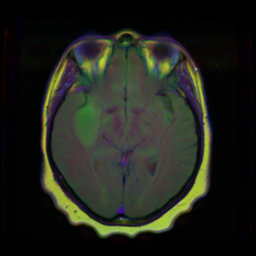This tutorial and the assets can be downloaded as part of the Wallaroo Tutorials repository.
Wallaroo Inference Server: U-Net for Brain Segmentation
This notebook is used in conjunction with the Wallaroo Inference Server Free Edition for U-Net for Brain Segmentation. This provides a free Wallaroo license for performing inferences through the U-Net for Brain Segmentation model. The U-Net model is trained to detect lower-grade gliomas.
This tutorial demonstrates how to:
- Convert sample images of brain scans to tensor values and perform inferences through the Wallaroo Inference Server Free Edition for U-Net for Brain Segmentation
Prerequisites
- A deployed Wallaroo Inference Server Free Edition with one of the following options:
- Wallaroo.AI U-Net for Brain MRI Segmentation - x64
- Access via port 8080 to the Wallaroo Inference Server Free Edition.
U-Net for Brain MRI Segmentation Model Schemas
Inputs
The U-Net for Brain MRI Segmentation Model takes the following inputs.
| Field | Type | Description |
|---|---|---|
input | Variable length List(Float) | Tensor in the shape (n, 3, 256, 256) float. This is the normalized pixel values of the 640x480 color image. |
Outputs
The U-Net for Brain MRI Segmentation Model takes the following Outputs.
| Field | Type | Description |
|---|---|---|
output | Variable length List(Float) | A flattened numpy array of detected objects. When reshaped into a (1, 256, 256) returns where the bounding for a detected glioma. |
Wallaroo Inference Server API Endpoints
The following HTTPS API endpoints are available for Wallaroo Inference Server.
Pipelines Endpoint
- Endpoint: HTTPS GET
/pipelines - Returns:
- List of
pipelineswith the following fields.- id (String): The name of the pipeline.
- status (String): The pipeline status.
Runningindicates the pipeline is available for inferences.
- List of
Pipeline Endpoint Example
The following demonstrates using curl to retrieve the Pipelines endpoint. Replace the HOSTNAME with the address of your Wallaroo Inference Server.
!curl HOSTNAME:8080/pipelines
{"pipelines":[{"id":"pt-unet","status":"Running"}]}
Models Endpoint
- Endpoint: GET
/models - Returns:
- List of
modelswith the following fields.- name (String): The name of the model.
- sha (String): The
shahash of the model. - status (String): The model status.
Runningindicates the models is available for inferences. - version (String): The model version in UUID format.
- List of
Models Endpoint Example
The following demonstrates using curl to retrieve the Models endpoint. Replace the HOSTNAME with the address of your Wallaroo Inference Server.
!curl HOSTNAME:8080/models
{"models":[{"name":"pt-unet","version":"5a0f70fc-e33b-487c-80c9-24e23e5621b5","sha":"dfcd4b092e05564c36d28f1dfa7293f4233a384d81fe345c568b6bb68cafb0c8","status":"Running"}]}
Inference Endpoint
The following endpoints are available from the Wallaroo Server for Computer Vision Yolov8n deployment.
- Endpoint: HTTPS POST
/pipelines/hf-summarizer-standard - Headers:
Content-Type: application/vnd.apache.arrow.file: For Apache Arrow tables.Content-Type: application/json; format=pandas-records: For pandas DataFrame in record format.
- Input Parameters: The images must be in 256x256 format converted to a float tensor.DataFrame in
application/json; format=pandas-recordsOR Apache Arrow table inapplication/vnd.apache.arrow.filewith the shape(n, 3, 256, 256)then flattened, with the tensor values in the fieldinput. - Returns:
- Headers
Content-Type: application/json; format=pandas-records: pandas DataFrame in record format.
- Data
- time (Integer): The time since UNIX epoch.
- in: The original input.
- images: The flattened tensor values for the original image.
- out: The outputs of the inference result separated by data type.
- output: The float outputs for the inference. This list is flattened, and when reshaped into
(1, 256, 256)that corresponds to a mask image showing the gliomas position.
- output: The float outputs for the inference. This list is flattened, and when reshaped into
- check_failures (List[Integer]): Whether any validation checks were triggered. For more information, see Wallaroo SDK Essentials Guide: Pipeline Management: Anomaly Testing.
- metadata: Additional data for the inference.
- last_model: The model used for the inference.
- model_name (String): The name of the model used.
- model_sha (String): The sha of the model used.
- pipeline_version (String): The pipeline version in UUID format.
- elapsed (List[Integer]): A list of time in nanoseconds for:
- [0] The time to serialize the input.
- [1…n] How long each step took.
- dropped (List): Any dropped input tables.
- last_model: The model used for the inference.
- Headers
Inference Endpoint Example
The Wallaroo Inference Server accepts pandas DataFrame or Apache Arrow tables as inference inputs. The sample file ./data/TCGA_CS_4944.png is used as the sample input.
The following code segment demonstrates converting the image to a DataFrame.
input_image = Image.open(filename)
display(input_image)
# preprocess
m, s = np.mean(input_image, axis=(0, 1)), np.std(input_image, axis=(0, 1))
preprocess = transforms.Compose([
transforms.ToTensor(),
transforms.Normalize(mean=m, std=s),
])
input_tensor = preprocess(input_image)
input_batch = input_tensor.unsqueeze(0)
nimage = input_batch.detach().numpy()
nimage.shape
The following code segment demonstrates performing an inference through the Wallaroo Inference Server with the U-net model deployed. Replace HOSTNAME with the hostname or IP address of your Wallaroo Inference Server instance.
# used to convert the Image into a numpy array
from PIL import Image
from torchvision import transforms
import pyarrow as pa
import numpy as np
import pandas as pd
import requests
# used to display dataframe information without truncating
from IPython.display import display
pd.set_option('display.max_colwidth', None)
filename = './data/TCGA_CS_4942_19970222_9.tif'
input_image = Image.open(filename)
display(input_image)
# preprocess
m, s = np.mean(input_image, axis=(0, 1)), np.std(input_image, axis=(0, 1))
preprocess = transforms.Compose([
transforms.ToTensor(),
transforms.Normalize(mean=m, std=s),
])
input_tensor = preprocess(input_image)
input_batch = input_tensor.unsqueeze(0)
nimage = input_batch.detach().numpy()
nimage.shape

(1, 3, 256, 256)
nimage = input_tensor.detach().numpy()
input_data = {
"input": [nimage]
}
dataframe = pd.DataFrame(input_data)
# inference request
headers = {
'Content-Type': 'application/json; format=pandas-records'
}
#
deploy_url = 'HOSTNAME:8080/pipelines/pt-unet'
response = requests.post(
deploy_url,
headers=headers,
data=dataframe.to_json(orient="records")
)
# display(pd.DataFrame(response.json()).loc[0, 'out']['output'][0][0][0:5])
# convert the image back to a dataframe
image_flat_tensors = pd.DataFrame(response.json()).loc[0, 'out']['output']
image_flat_tensors[0][0][0:5]
[1.42915e-05, 1.4762122e-05, 1.4074442e-05, 1.3313269e-05, 1.4010605e-05]